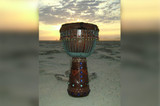The Mystery and Magic of Tablas
The tablas are an important drum in the country of India. It is said to have been invented by a Sufi poet in the 13th century, however Hindu temple carvings place the drum origins closer to 500 BC. The tablas can be called an Indian version of the bongos. The smaller drum (the tabla or dayan) is played with the dominant hand, while the larger drum (the bayan) has a deeper tone and is usually constructed of a different material. The Tablas has four surfaces on the set of drums that produce different sounds: The center circle (syahi), the ring after the syahi (maidan), the outer circle (chat) and the side of the drum (gajara). The drums are played with a dizzying fingertip and palm technique that is delightful to watch and challenging to master.
A drum interested in providing both comfort and beautiful sound, the tablas are played while sitting on the floor. They are part of a long, oral tradition in which classical Indian music was passed from master to pupil and used to share the religious stories of the Hindu faith. Traditionally, the larger drum was made of clay, but it is typically made of metal these days. The smaller drum is made of seasoned wood and is tunable. While the exact history of the drum may be in question, the modern version of the tablas is said to have been invented in the early 18th century and many stylistic specialties have been created since then.
In the world of the tablas, there are distinct schools of playing. These schools are based upon region and called gharanas. Until recently, learning the tablas required a special guru/disciple relationship and the styles of the gharanas were heavily guarded. Playing styles and compositions were passed from teacher (guru) to student (disciple) and required years of intense devotion. The guru would even pass down secret family compositions, so this was an extremely special relationship cemented with a special Hindu temple ceremony. Even today, there are guru/disciple apprenticeships and that is how many percussionists learn to play the tablas.

Part of the historical devotion of learning to play the tablas is a special rite of passage called Chilla. Chilla means, literally, 40 days and the rite once consisted of tablas dedicatees holing themselves up in a lightless room for 40 days with the sole purpose of playing the tablas. They would only stop to use the restroom or eat easily digestible food and were only allowed to see the person bringing the food. This intense training served as way of connecting the serious student to the practice in a deeper fashion. Before taking on Chilla, the disciple would vow to play as long as he was awake, spending hours connecting with this powerful instrument.
Recent Posts
-
What is the Best Size Djembe for Beginners?
If you're new to the world of percussion and interested in learning the djembe, you're in for a t …16th Jul 2024 -
The Benefits of Becoming a Drumming Teacher: Transforming Passion into Profession
Why become a drumming teacher? Becoming a drumming teacher is an excellent way to share your pas …22nd May 2024 -
What Makes the Djembe Drum a Spiritual Instrument in African Music?
Origin and history of the Djembe drum The Djembe drum originates from West Africa and holds sign …16th May 2024




